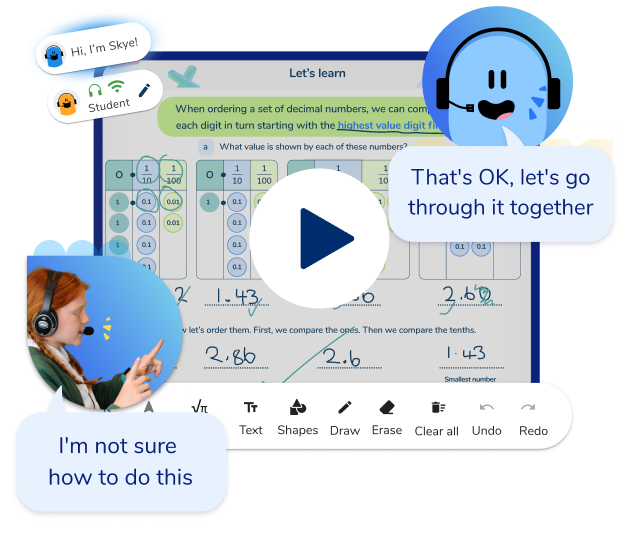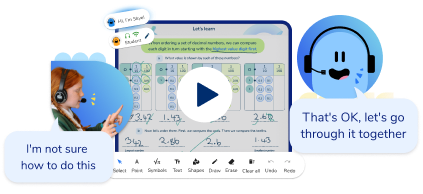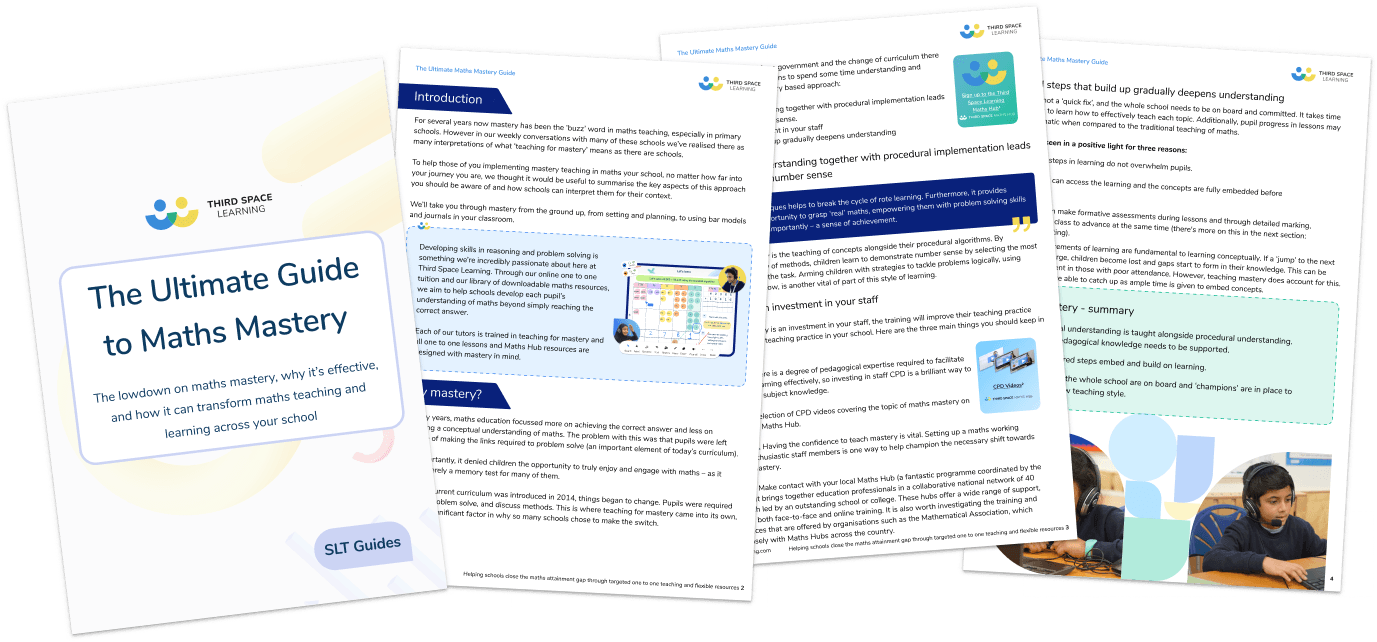What Is Maths Mastery? The 10 Key Principles Of Teaching For Mastery In Maths
Maths mastery, teaching for mastery in maths, and the mastery approach to teaching and learning are now phrases heard all through the school system but there are still countless discrepancies about what they means, what mastery looks like, and how to implement it.
In this article Neil Almond takes the principles of mastery mathematics teaching as set out in Mark McCourt’s booking Teaching for Mastery to provide an easy to digest primer on the 10 points every primary school teacher and SLT should know before embarking on their ‘journey to maths mastery’.
To get you started, here are some simplified definitions before we move onto the meat of the issue – and why there are so many misconceptions around the meaning of mastery in maths.
- What is maths mastery?
- What is teaching for mastery?
- NCETM mastery
- Maths mastery schemes of work
- Who is Mark McCourt?
- 1. Teaching For Mastery Is An Old Technique, Not A New One
- 2. Benjamin Bloom Codified And Formalised Mastery Teaching
- 3. There Are Six Core Elements To The Teaching for Mastery Model
- 4. The Role Of The Teacher In Mastery Teaching Is Paramount
- 5. Mastery Teaching Requires A Positive Relationship Between The Pupil And Teacher
- 6. A Conveyor-Belt Curriculum Makes True Maths Mastery Teaching Difficult To Implement
- 7. All Students Can Learn Maths, Given The Right Conditions And Time
- 8. Teaching For Maths Mastery Has To Start From Day One
- 9. An Understanding Of Cognitive Science Is Key To Maths Mastery Teaching
- 10. Teach Everything Correctly The First Time
What is maths mastery?
Maths mastery is a teaching and learning approach that aims for pupils to develop deep understanding of maths rather than being able to memorise key procedures or resort to rote learning.
The end goal and expectation is for all pupils (with very limited exceptions) to have acquired the fundamental facts and concepts of maths for their year or key stage such that by the end of it they have achieved mastery in the maths they have been taught. At this point they are ready to move confidently on to their next stage of maths.
Mastery of a mathematical concept means a child can use their knowledge of the concept to solve unfamiliar word problems, and undertake complex reasoning, using the appropriate mathematical vocabulary.
Maths mastery is a not a quick fix to maths learning but a journey that the teacher and pupils go on together, with regular diagnostic assessment to check the pupils understanding and direct instruction that teaches to any gaps.
The Ultimate Guide to Maths Mastery
This guide provides essential information for implementing a mastery approach to mathematics in primary schools. Use for staff meetings and self-assessment.
What is teaching for mastery?
Teaching for mastery is the how the teacher (crucially with support of their school) organise their classroom time and teaching preparation time in order that their pupils can go on the journey of mathematics mastery together.
NCETM mastery
NCETM, the National Centre for Excellence in the Teaching of Mathematics has championed the Singapore and Shanghai approach to mastery maths since the start of the new curriculum.
They have further codified it for their maths hubs training hundreds of primary maths teachers to include ‘5 big ideas in teaching for mastery’ ie
- Coherence
- Representation and Structre
- Mathematical Thinking
- Fluency
- Variation
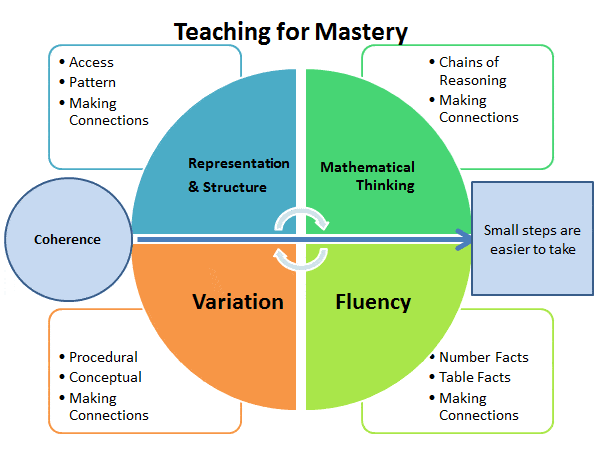
Maths mastery schemes of work
There seems to have been, in the last 3 to 5 years, a resurgence of the word ‘mastery’ in educational discourse – especially around maths education since the introduction of the new primary national curriculum.
Every other primary mathematics scheme advertises proudly they take a ‘mastery’ approach to maths. Yet teachers’ understanding of what ‘mastery’ is seems to be limited to getting pupils to ‘master the content’ which doesn’t really narrow it down very much, nor does it offer any special insight beyond what we all aim to do as teachers.
In his recently released book, Teaching for Mastery, Mark McCourt gives the history and an overview of the classroom applications of the mastery model of schooling, and that is what I will be taking a closer look at in this post with particular reference to how it applies to KS1 and KS2 maths teaching at primary school.
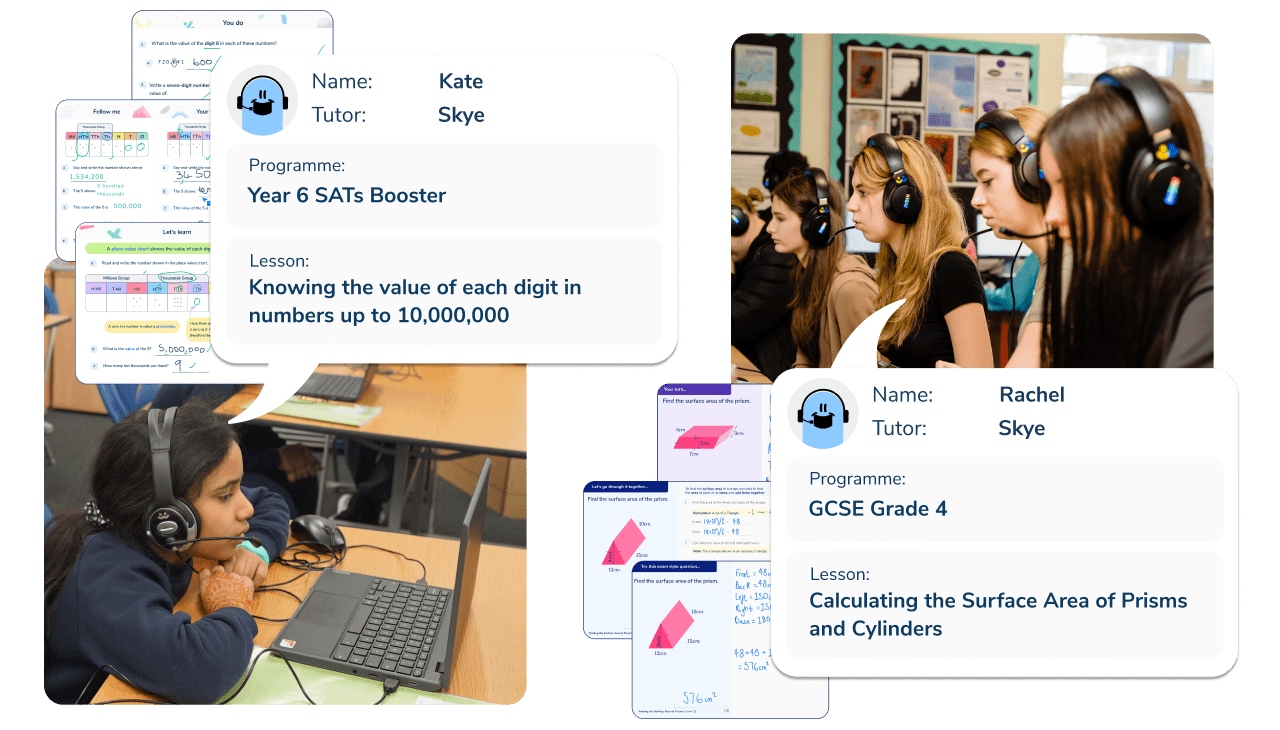
Meet Skye, the voice-based AI tutor making maths success possible for every student.
Built by teachers and maths experts, Skye uses the same pedagogy, curriculum and lesson structure as our traditional tutoring.
But, with more flexibility and a lower cost, schools can scale online maths tutoring to support every student who needs it.
Watch Skye in actionWho is Mark McCourt?
If you’re not familiar with him Mark McCourt is a tour de force in secondary school mathematics education, and a leading authority on the mastery models of teaching.
He has been a teacher, senior leader, headteacher and inspector
Mark was a Director at the NCETM and is currently the CEO of La Salle Education, which provided provides professional development to schools and teachers. You can hear him speak at mathematics conferences but also on these episodes of the Mr. Barton Maths podcasts:
Podcast with Mark McCourt 1
Podcast with Mark McCourt 2
His book, Teaching for Mastery, is subject-agnostic, meaning its principles can be applied to all subjects taught in schools but many examples focus on mastery maths lessons. It’s an essential read for all maths teachers, primary or secondary.
Here are the ten key principles from his book
1. Teaching For Mastery Is An Old Technique, Not A New One
The mastery model of teaching takes its influence from Ancient Greece and the work of Greek philosopher Aristotle (who lived approximately 2300 years ago).
The 1-to-1 tutor model, where the tutor is very much aware of the prior attainment of the students, knows where to take the learning next and, more importantly, can correct any misconceptions the student may have, is the firm foundation of the mastery approach to schooling.
This is the method that underpins Third Space Learning’s own one to one tuition maths programmes in school where individual misconceptions are fixed as they arise. The tutors are trained to ensure that every pupil works to fully understand the maths topic they are taught before moving onto the next.
The idea of teaching for mastery in a school is that you then just scale this approach up so that you get the effect of a one to one maths tutor even with 30 children. Of course this is hard to achieve in practice. The person who pioneered this movement of aspiring to mastery teaching was Carleton Washburne in the early part of the 20th century.
2. Benjamin Bloom Codified And Formalised Mastery Teaching
In the 50s and 60s Benjamin Bloom (yes, as in Bloom’s taxonomy) took on Washburne’s model from a similar starting point – to improve the impact of schooling on the disadvantaged where previous models didn’t. He knew that if children were given the right amount of time to learn at their pace with appropriate conditions, then every child would be able to learn the content and master it.
Can we say the same about the maths mastery model we are using to teach pupils the primary maths curriculum today?
Benjamin knew his model would have 2 key features:
- The crucial, successful elements of 1-to-1 tutoring, which could be transferred to a group-based environment
- The dispositions of academically and successful pupils in a group-based environment
Bloom noted that academically successful pupils used assessment as a means to improve their own understanding and not just to rank themselves against the rest of the cohort.
This, along with carefully designed assessment to identify misconceptions, could then be refuted and corrected by the teacher immediately. Bloom wrote all of his work the mastery model in 1968, in a publication entitled ‘Learning for Mastery’, where he discusses elements of the mastery program such breaking content down into smaller units that last approximately a week or two and that frequent formative tests are used to see if the content has been mastered (Bloom, 1968).
In primary schools following a maths mastery approach this is now fairly standard behaviour. In most schemes, not just White Rose Maths although that is very popular, not only is the content broken down into smaller units, but there are regular formative checks built in to ensure that pupils have grasped what’s been taught.
3. There Are Six Core Elements To The Teaching for Mastery Model
In his book, Mark identifies six core elements of teaching for mastery from the work of Guskey (2010).
- Diagnostic pre-assessment with pre-teaching
- High-quality, group-based initial instruction
- Progress monitoring through regular formative assessment
- High-quality corrective instruction
- Second, parallel formative assessment
- Enrichment or extension activities
These same 6 elements are therefore the heart of a maths mastery approach.
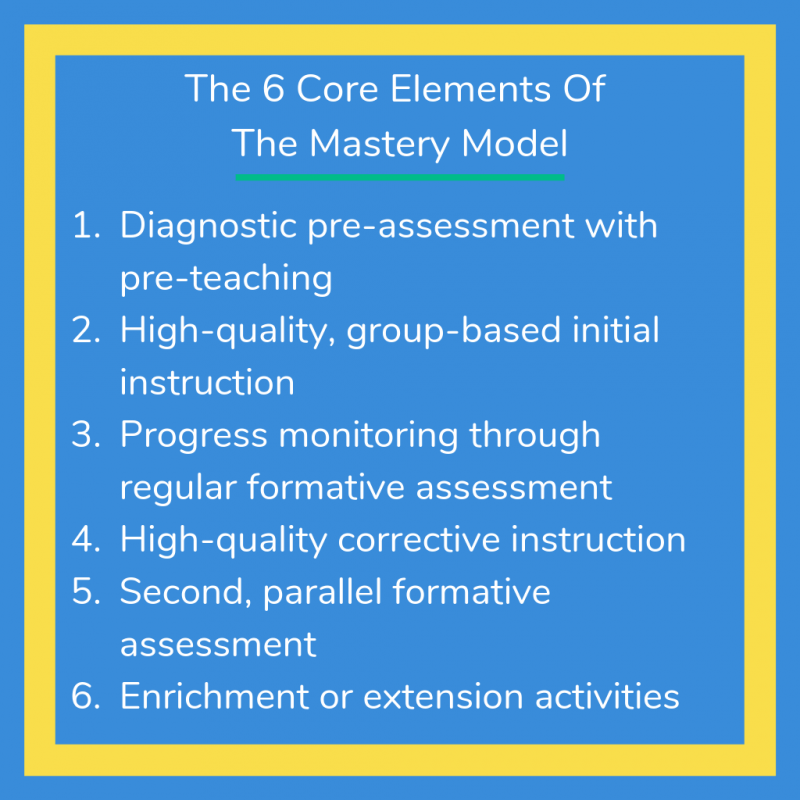
1. Diagnostic pre-assessment with pre-teaching
In the first element, careful pre-planned assessments are used to tease out any misconceptions that a student may have before a topic commences. In essence, this part of the model is to check to see if the students have the prior knowledge needed to tackle the new learning that is coming up. Depending on the results, pre-teaching would then take place to ensure students are ready to progress onto the new idea.
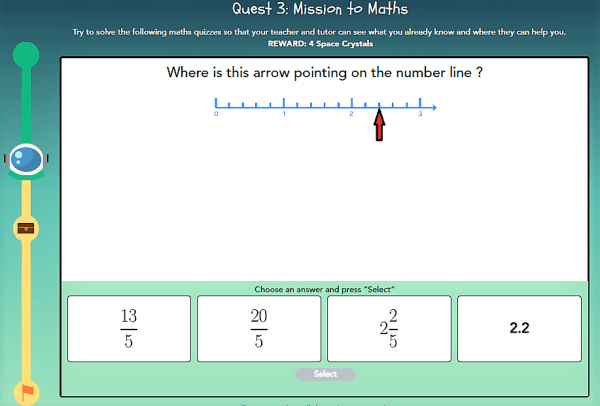
For primary school teachers to really make use of this, find questions on the same topic but for the previous years objective and give those to the students before starting a new topic. Use the information from that assessment to ensure appropriate pre-teaching for those who will need it.
Read also: Your Maths Intervention Must Have – Formative Diagnostic Assessment
2. High-quality, group-based initial instruction
In the second element, mastery models ‘emphasise the importance of engaging all students in high-quality, developmentally appropriate, research-based instruction in the general education classroom’ (Guskey, 2010) to ensure the maximum chance of success for the students.
Read also: Explicit Instruction and Worked Examples in Primary Maths
3. Progress monitoring through regular formative assessment
In element three, regular formative assessment takes place to elicit understanding of what has been taught already i.e. to ensure the intent from the second element has been understood. Students would be expected to answer questions directed to them by the teacher and complete mini-quizzes for example. Teachers would act on this information and provide immediate feedback as necessary.
Read also: The Difference Between Formative And Summative Assessment
4. High-quality corrective instruction
The fourth element refers to the teachers’ actions when they have learnt that a student has not grasped an idea. This is not the same as reteaching what you have taught the same way. The knowledgeable teacher would be expected to draw on their vast pedagogical and didactic knowledge to present the content in another way that the student could understand. Guskey (2010) writes, ‘for a unit of a week or two in length, for example, corrective instruction might last one or two days.’ However, this time is later recovered as students are well versed in all prior topics.
The primary school maths teacher must be able to draw on visuals, manipulatives and a variety of metaphors and examples so that the student has the best chance of understanding the topic.
Read also: Common Maths Misconceptions and How To Overcome Them
5. Second, parallel formative assessment
In the fifth element we continue cycle of teach and check for understanding as a result of changes brought in at the fourth element. An important feature of the mastery model is that this is not the final assessment of this topic. Mark draws on the analogy of driving. If you do not pass, the cycle of learning and practice continues until you have mastered the content.
6. Enrichment or extension activities
The final element is to provide challenging enrichment activities that provide a valuable learning experience but, crucially, does not move them on to new mathematical ideas – it may look at previously taught ones . While those that have passed the assessment of the unit move on to this, those that fail will continue to receive corrective instruction until they pass.
It is important that the content provided here is additional material that not everyone needs to access. Primary school maths leads should make clear with the year groups which content is required for all students to know and which is additional depth study that can be given to those who master a mathematical concept quicker than others.
Read also: What Greater Depth In KS2 Maths Looks Like
4. The Role Of The Teacher In Mastery Teaching Is Paramount
Despite Carleton’s early influence of the educational philosopher Dewey, the work done by psychologist Fred. S Keller in adapting behaviourists’ ideas into educational resources that allowed students to study at their own pace with minimal instruction from a teacher (which were being developed at the same time Bloom was looking at the work on mastery) both Carleton and Bloom appreciated the crucial role of the teacher in the mastery model.
As in the Aristotelian one to one tutor method, in order for the student to be successful, the tutee needed an experienced and knowledgeable tutor. From the six elements of the mastery model, you can see how the teacher plays a key role in each section:
- The teacher will design or locate appropriate pre-assessment activities that will clearly demonstrate specific misconceptions that the expert teacher can correct in real time.
- The teacher will deliver the first and second wave of high-quality instruction but also know countless ways of explaining different ideas so that all learners have the greatest opportunity to succeed.
Mastery Teaching Doesn’t Begin At The End Of Your NQT Year
In the book, Mark challenges the idea that after the NQT year we are all expert educators.
He argues that all learners go through the continuum of novice to experts, with training or early career teachers spending time on the superficial, usually asking themselves things such as:
- What am I saying?
- How long should I do this for?
- What do I do next?
Eventually, teachers progress through the novice/expert continuum where the focus is on strategic knowledge – lessons learnt from teaching to get better. Mark states that this process can take around 10 years of teaching mathematics.
This is certainly the case when learning how to properly administer maths mastery, as well as other subjects within the curriculum.
Primary teachers, in fact all teachers, need to know that they can always improve and become more effective. SLT should look to see what the best CPD they can offer to their staff is. Particular focus should be on the didactics of maths teaching, for example, the use of maths manipulatives.
This should be followed up continuously and not as a box-ticking exercise.
Read more
- Free Maths Mastery Toolkit & Resources For Primary Teachers
- What Metacognition Looks Like At Primary: 7 Steps for Implementation
- Quality First Teaching: What It is And How To Make The Most Of It
- 21 Best Maths Challenges To Stretch Your Most Able Pupils
5. Mastery Teaching Requires A Positive Relationship Between The Pupil And Teacher
Learning is a social event and for the pupils to have some buy-in to the mastery model of schooling, they need to have confidence and faith in the teacher delivering the content.
They need to know that the teachers are the holders of this knowledge and that they deem it important enough for the students to know. As Mark says, ‘In order to accept new knowledge as truth, the people first must believe that the teacher is a carrier of truth and is sincere in their desire for the pupil to become learn’d.’

We know that in order for learning to happen, pupils must attend to and think about what is happening – this will only happen when those positive relationships have been developed. To get a mastery model of teaching, you need to get behaviour right too!
While it may seem tempting to get the ball rolling quickly at the start of September, take the time in your primary classroom to embed routines, especially those relating to maths task, like getting whiteboards and pens out and giving out and taking in manipulatives.
The time spent doing this and embedding these behaviours at the start of the year will pay dividends for the remainder of it and give you much more time for learning.
Read also: Why You Should Follow Mastery In Maths: 6 Real Benefits
6. A Conveyor-Belt Curriculum Makes True Maths Mastery Teaching Difficult To Implement
So far I imagine nothing that has been said here is controversial or that new to teachers, yet to achieve a mastery model of schooling in our current system in impossible to replicate due to one reason – year groups.
Mark McCourt is very sceptical of what he calls ‘Conveyor-belt Curriculums’ which is the type of curriculum that is currently used in the UK.
This approach is when content is delivered to learners based around age expectations. A Year 2 child will automatically progress to Year 3 – and the content that comes with it – despite them not grasping the Year 2 content.
The conveyor-belt cannot be stopped as teachers need to progress ‘through the curriculum.’ What then often happens is that learners are left floundering with the new ideas from the new content or are removed from other lessons to have interventions.
In the mastery maths model for schools – in its true sense – learners must understand all the content that is has come before advancing to the new stages. Therefore, truly achieving the mastery model is impossible given the constraints of the curriculum from the government.
We can, therefore, only use principles from a mastery programme to inform our pedagogical thinking to fit the current conveyor-belt system that we find ourselves working in.
The best that can be done would be to create highly homogenised groups of students with a narrow attainment gap and start the mastery maths model with them.
All those primary school teachers now teaching the whole class with mixed ability grouping in maths may at least want to review or discuss with the rest of your team whether this is the best approach.
Read more: Spiral curriculum
7. All Students Can Learn Maths, Given The Right Conditions And Time
Linked to the idea above comes another answer to what is teaching for mastery.
It is the most powerful and important idea of the model – that given the appropriate time and conditions, ALL students can learn the content, even when it’s the primary maths curriculum!
Time is one of the most precious resources teachers have; it is imperative that we spend this resource as wisely as possible. Mastery is not to be seen as a detailed scheme of work that labels a unit with a year group, or week number or a lesson number.
If you hold onto the belief that learning can take place within the time confinements of one lesson of one hour in length or that ‘progress’ can be shown within minutes of pupils arriving in the classroom then you cannot be said to be implementing the mastery model.
The mastery model moves from the question of ‘Have I taught the curriculum? to ‘Has the curriculum been learnt?’
The right conditions would be seen as the pupil/teacher relationship and the pedagogical and didactic choices that the teacher would employ when embarking on the second element of the mastery model – high-quality grouped instruction.
What else is clear in his book is the role the student plays in their own learning. Another point central to the mastery approach is that of effort. The student is expected to put a lot of effort in to achieve what the teacher has promised they will learn.
SLT need to ensure that there is a culture in your primary school that students need to give their full effort to everything that they try and, while they may not be successful the first time, if they keep at it they will be. For some schools this may already be embedded as part of a culture of growth mindset.
Teachers need to ensure they create the right conditions. They do this by making sure they use the time given to them wisely and plan appropriate interventions to ensure any missing background knowledge is learnt, using strategies for differentiation in the classroom that seek to ensure the raising up of as many pupils as possible.
8. Teaching For Maths Mastery Has To Start From Day One
For the mastery-model to be truly effective and sustaining, it has to start from day one – reception. The only way that it could work through primary school would be through a rigorous and well-structured plan – that could take up to 2 to 3 years- and a tremendous amount of CPD for staff.
As Mark puts it, ‘Training should focus on ensuring that a subject teacher has multiple approaches for every concept they will be required to teach. This becomes the profession’s body of knowledge. The canon of how to teach.’
It is therefore not sufficient for a school to decide late in the summer term that there will be a change of teaching model to the mastery model late in the summer term and this is to be expected to occur across all year groups with only two INSET days to support it.
It should be a rolling program (that is, it begins in reception and goes up with that year group) with each year group receiving as much CPD as required for the model to be successful.
There are many benefits to maths mastery being the initial programme of teaching for mastery that you introduce into your primary school. Maths lends itself well to this mastery approach due to its more structured nature in comparison to some other school subjects.
9. An Understanding Of Cognitive Science Is Key To Maths Mastery Teaching
The aim of the mastery model is to ensure that all learners have understood and remembered what has been taught.
To give us the best chance of this happening, it is important to draw on the canon of knowledge that cognitive science has given us over the last 50 years and implement this in our instructional phases.
While there is not enough time to go into all the detail, the key elements of cognitive science that teachers should be aware of in their maths mastery teaching are as follows:
- Working memory/Long-term memory
- Cognitive Load Theory and the various effects that come with that
- Schemas
- Retrieval and the testing effect
- Desirable difficulties – spacing, interleaving
- The hypercorrection effect
- Learning vs Performance
Many of these topics are covered in Craig Barton’s book, How I Wish I’d Taught Maths, which Third Space has covered in a series of blogs on teaching maths for primary teachers by Clare Sealy. Start with this one on cognitive load theory in the classroom.
By having an understanding of the above, teachers can really begin to think about the choices that they make in the classroom in regards to explicit instruction and the way they deliver their main teaching in a way that will promote learning for long-term retention.
10. Teach Everything Correctly The First Time
Finally, if you’re looking for a one sentence answer to achieving maths mastery through the mastery model of teaching, it’s quite simple: teach everything right the first time.
Where teachers have to rush through to complete the curriculum, tricks or sometimes lies are often used to cover that content quickly, such as telling children in KS1 that you cannot take 8 away from 6, for example or steps are skipped such as rote learning times tables without exploring the relationships between tables.
Mark argues that this creates two problems.
Firstly, it breaks down the relationship between the pupils and the teacher as the teacher is exposed as a liar and therefore not a person to be trusted – the suggested course of action here is to tell the student it is possible, and that this will be covered when we look at another type of subtraction.
Secondly, it does not improve a learners mathematical understanding. Mark makes the case that teachers should be taught in the didactics of maths – the technical detail – so that from the very beginning, we are getting things right for the learners in our care.
By doing this we help them develop mathematical fluency and reasoning skills, both of which are key to helping them become better as mathematicians and in their problem solving.
Pedagogy is not enough.
It is only through the careful selection of pedagogy and knowledge of multiple didactic choices will we allow students to see the interconnectedness of mathematical ideas.
We should not see maths as a set of procedures to learn and curriculum to get through but rather see it as a journey to understand the universe we are in (according to Mark there are 320 mathematical ideas to learn to know the body of maths) and these should be taught correctly the first time so that everyone can understand them and be part of the conversation.
Mathematics mastery teaching and learning may be a long procedure, but it is one that is certainly worth the effort you will be putting in to get there.
Sources of Inspiration
McCourt, M (2019). Teaching for Mastery. Woodbridge: John Catt Education
Bloom, B. S. (1968). Learning for Mastery. Instruction and Curriculum. Regional Education Laboratory for the Carolinas and Virginia, Topical Papers and Reprints, Number 1. Evaluation Comment . Washington, D.C., USA: Office of Education.
Guskey, Thomas. (2010). Lessons of Mastery Learning. Educational leadership: journal of the Department of Supervision and Curriculum Development, N.E.A. 68. 52-57.
DO YOU HAVE STUDENTS WHO NEED MORE SUPPORT IN MATHS?
Skye – our AI maths tutor built by teachers – gives students personalised one-to-one lessons that address learning gaps and build confidence.
Since 2013 we’ve taught over 2 million hours of maths lessons to more than 170,000 students to help them become fluent, able mathematicians.
Explore our AI maths tutoring or find out about primary maths tutoring for your school.
